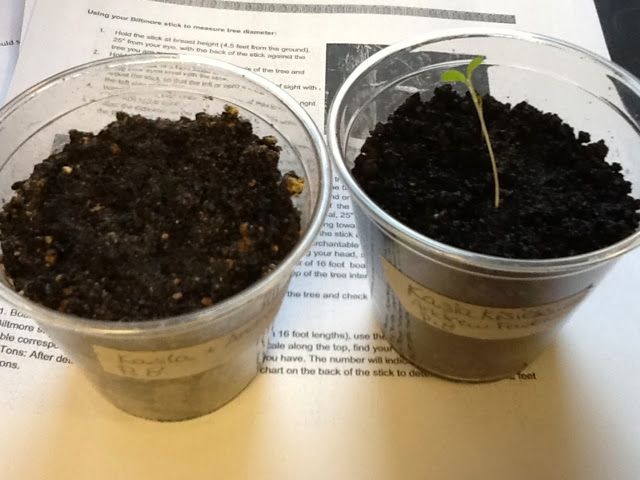Monday, November 25, 2013
Conclusion
Sunday, November 24, 2013
Controlled Experiment
Remediation
Salinization
Thursday, November 14, 2013
Soil Dry Percolation Rate
Percent Organic Matter
In this experiment, to find the organic matter percenage, we needed to burn the soil that had come from the drying oven at high temperatures to convert as much of it possible into carbon dioxide and water for 30 minutes. The soil needed to be dry enough to measure and calculate the mass lost during the burning of the soil. The burning is shown here:
It is not necessary to measure the mass of the soil alone because the mass of the crucible is constant and its mass was essentially subtracted out when the percentage of organic matter was calculated. Using the following collected data:
Crucible with organic matter: 83.8g
Weight before burning crucible with organic matter: 74.4g
Empty crucible: 63.3g
It calculated that the total percent of organic matter was 11.2%, using the original container mass (83.8 grams) minus the weight after burning (74.4 grams) to equal 9.4, which was then divided by the riginal weight and multiplied by 100 to find the percent, or (83.8 g - 74.4 g) = (9.4 / 83.8 g) x 100 = 11.2%.
It is very important to have organic materials in soil because it serves as a reservoir of nutrients and water, aids in reducing compaction and surface crusting, and increasing water infiltration, allowing for more successful plant growth and prevention of erosion.
- Kasia
Soil Texture Test
The purpose of this experiment was to calculate the percentage of sand, silt, and clay in the specific soil we have. In the graduated cylinder the soil was put to 60-70 ml mark, then water was poured to the 100ML mark:
Then it was gently shaken to reduce soil lumps. After the procedure was successfully finished, the graduated cylinder with the soil sample was set to wait at least 24 hours to settle the particles in the soil:
The calculations have shown that the soil was completely silted with a small amount of clay. There was a very small variation of soil types in this specific type of soil we had. The silt has medium-sized particles, so it holds some water, but not too much. It holds some nutrients, but not as many as clay. It warms up fast in spring, but not as quickly as sand. The percentage of silt that existed in our soil was about 90%. Some form of clay was also present in our soil type. About 10% was clay that was forming on the top layer of the soil types. The denser, larger sand particles will settle out first and be on the bottom of the cylinder. Clay is essential to our soil. Clay soil is naturally high in nutrients and holds moisture well, keeping plants hydrated.There was no sign of sand that existed in our soil.
The pyramid shows the different types of soil types that can exist in your specific soil you have collected. On the pyramid the bottom right corner, which is silt is the section on the pyramid that is shaded for our soil type:
The 10% of the clay and 90% of the silt lined up the pyramid at the right side where they meet at silt.
This compares to the qualitative method because the calculations that have been taken, result in the percentages that determine the amount of soil type. There was 90% of silt, 10% of clay and 0% of sand. There was no sand that should have rested on the bottom of the graduated cylinder. The qualitative test was done to produce a short "ribbon" of soil, and helped us determine that the soil was silt, as seen here:
Overall, our soil type was consistent with our percolation test results to be that of silt. As we compared our soil types with other classmates, we have come to conclusion that the soil types are very similar. Most of all, they contain little or no sand it all. There was a lot of silt present and less than half of clay. That means that the soil in Lake Zurich is mostly silt and clay. Silt is very fine sediment that is formed by the process of erosion. It is usually found in or near bodies of water or where bodies of water once existed. The city, Lake Zurich has a Lake in its surrounds. We can assume that’s where the vast majority of silt has come from.




































